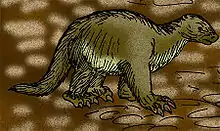Oreomylodon
Oreomylodon is an extinct genus of ground sloth in the family Mylodontidae, endemic to Ecuador during the Pleistocene. The only species, O. wegneri, was long considered to be either a species or subgenus[1] of Glossotherium (as G. wegneri) or a junior synonym of Glossotherium robustum, but studies of its cranial anatomy published in 2019 have supported Oreomylodon as a valid genus, and suggested it is more closely related to Paramylodon. It shows adaptations to living in a high-altitude habitat, and its fossils have frequently been unearthed in the Interandean Valles of Ecuador, at elevations of between 2,450 and 3,100 meters.[2]
| Oreomylodon | |
|---|---|
| Scientific classification | |
| Kingdom: | Animalia |
| Phylum: | Chordata |
| Class: | Mammalia |
| Order: | Pilosa |
| Family: | †Mylodontidae |
| Subfamily: | †Mylodontinae |
| Genus: | †Oreomylodon Hoffstetter 1949 |
| Species | |
| |
References
- Martin, Paul S.; Klein, Richard G. (1989). Quaternary Extinctions: A Prehistoric Revolution. University of Arizona Press. p. 54. ISBN 9780816511006.
- Román-Carrión, José Luis; Brambilla, Luciano (2019). "Comparative skull osteology of Oreomylodon wegneri (Xenarthra, Mylodontinae): defining the taxonomic status of the Ecuadorian endemic ground sloth". Journal of Vertebrate Paleontology. 39 (4). doi:10.1080/02724634.2019.1674860. S2CID 209439994.
This article is issued from Wikipedia. The text is licensed under Creative Commons - Attribution - Sharealike. Additional terms may apply for the media files.

